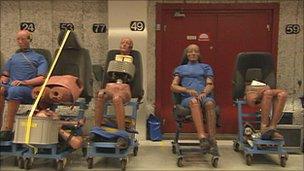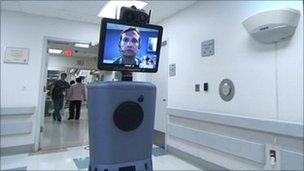A future without car crashes?
- Published
- comments
More than a million people die around the world in car accidents each year but experts in the industry now believe fatal smashes could be eliminated. Some hope there could be an end to car crashes altogether.
Accidents can be caused by a multitude of reasons, but human error is at the heart of them. Drivers go too fast for the weather conditions, make unwise decisions and fail to notice or anticipate potential hazards. But what if the car could help the errant driver?
Scientists and engineers are developing technology and enhancements to cars that would aid drivers to the extent that crashes would become rarer events. Bad weather conditions and poor judgement would be mitigated by the car itself. Drivers, passengers, cyclists, pedestrians and motorcyclists could one day be protected from bad driving.
Sophisticated technology is also being mapped out to ensure drivers and passengers can survive even catastrophic accidents.
Auto-braking

The car stops automatically before hitting the balloon car on the Volvo test track
Volvo believe in the future they can stop cars from ever crashing. They are developing auto-braking technology to ensure cars come to a stop when they sense another car coming close to them - both from the front and the side.
Scientist Erik Coelingh has been testing his crash avoidance technology at their test track in Sweden.
"The car has a sensor system that tries to detect where the objects around the car are.
"There is a GPS measurement unit, a sensor on the roof and we measure the location. And what we really want to know is the relative position of this car as compared to the balloon car [test car]."
Early tests are good, the car stops automatically before hitting the balloon test car, despite Mr Coelingh's foot being on the accelerator.
He has high hopes for the research being carried out at Volvo: "We believe that accidents are not inevitable.
"And we have a vision that in - in the future there will be no collisions, will be no fatal accidents with vehicles any more."
The intelligent windscreen

Three infrared cameras precisely monitor the direction of the gaze of the driver
At General Motors' research lab in Detroit, scientists are investigating how the car itself can make up for our shortcomings - by enhancing the driver's senses.
They are developing a prototype windscreen, which they hope will give drivers a kind of "superhuman" vision - the Advanced Vision System.
"What we aim to do is not change a viewer's perception of the world, we just want to augment key features on the world," says Thomas Seder, the man behind the project.
Infrared cameras film the driver to monitor head position and gaze direction.

The blue line shows the driver the edge of the road which is hidden by fog
An awareness of exactly where the driver is looking allows the car to assist them when the going gets tough.
"One of the common driving scenarios that we can help with is the situation where you're driving on a foggy road," says Mr Seder.
"[We can] highlight the edge of road, augmenting reality effectively, making it more apparent to you so that you can release your attention to other things that you should be scanning for."
Virtual crash test dummy
Crash test dummies have been at the centre of car safety research but their days could be numbered as scientists around the world are working on a virtual dummy. It is the biggest coordinated research effort in car safety history.

Volvo's crash test centre in Sweden has a family of 100 crash test dummies of all shapes and sizes
Physical dummies simulate the dimensions, weight proportions and articulation of the human body but they aren't representative enough of real humans.
Scientists in labs around the world are working out the maximum force that every part of the body can take before irreparable damage occurs. They are starting with individual cells in the body and working upwards from there.
The information gathered will then be able to update existing dummies with a brand new virtual model, which will be able to predict the exact moment crash forces become too much for people to cope with.
Scientists like Warren Hardy believe virtual dummies will revolutionise car safety.
"There are a number of reasons to go toward that type of model as opposed to the physical model. In the virtual world we can do a lot more for a lot less," he says.
Robot doctor
Doctors at Jackson Memorial Hospital in Miami, Florida, are developing a robot doctor. Also known as advanced telemedicine, the robot doctor allows top surgeon Dr Antonio Marttos to control a robot bearing his image from a remote location.

The robot doctor can move around the hospital without assistance
He is able to communicate directly with the team at work in the accident and emergency unit. By controlling cameras on the robot, Dr Marttos can make a rapid diagnosis, and talk the resuscitation team through advanced procedures which might be needed straight away.
Research has found that when treating car crash victims the first hour after impact is critical. Called The Golden Hour, in that time the brain starts swelling and potentially devastating damage can develop.
Dr Marttos believes providing fast, expert treatment like this for car crash victims will save time and lives: "I can really support the nurse or physician from long distance, and really help them to have the best expertise always."
He is also developing a small device that can be taken to the scenes of accidents.
"I can help them to manage the patient and then when the patient arrives here I know what I'm receiving," says Dr Marttos.
Car that predicts injuries
Technology is already available that enables cars to alert the emergency services if something has happened that's not within the normal range of driving and might mean danger to the occupants.
A computer in the car sends a message and exact location of the car. This technology is already on the market in thousands of cars in North America.
But at Jackson Memorial Hospital, trauma surgeon Dr Jeff Augenstein is now taking this to the next level.
He is running a trial project where the computer in the car can also transmit detailed information about the crash forces experienced by passengers.
"Typically the change of velocity, how fast the car stopped going, what the angle of the primary impact was," he explains.
The computer programme is called the Urgency Algorithm.
"(It) takes all the data that the car can provide and comes up with a determination of whether severe injury could occur.
"It tells us to hone in on some things, that may not be obvious."